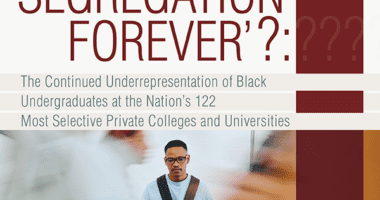Increasing College-Going and Graduation Rates for Low-Income Students
Two new reports from The Education Trust offer lessons from high-performing and fast-gaining colleges
WASHINGTON (January 16, 2014) - On their own, universities can, through sustained efforts, radically reshape success rates for low-income students and students of color without greater selectivity in admissions, according to two reports released today by The Education Trust. These reports come as the Obama administration calls for institutions of higher education to improve their college-going and completion rates among low-income and minority students.
”The growth of economic inequality and decline of social mobility in recent decades has made it that much more important that we radically increase the number of low-income students and students of color completing a college education,” said Kati Haycock, president of The Education Trust. “Leading colleges and universities are teaching us that just letting more students in isn’t enough. Colleges need to assume their share of responsibility for making sure students have the supports they need to complete.”
The first report, Learning from High-Performing and Fast-Gaining Institutions, examines practices at eight leading universities that markedly improved graduation rates over a sustained period of time especially among students of color and for low-income students. While each university approached the problem a little differently, their efforts had three features in common:
- Campus leadership - including the president and especially the provost - deeply and publicly committed to making student success a high, institution-wide priority;
- A self-described data geek in a key leadership position who used data as a tool to engage the campus community as problem-solvers and to build a culture oriented toward improving graduation rates for all groups of students;
- and Ongoing use of data to identify problems and evaluate solutions.
In almost every case, these institutions now have very sophisticated student success data management systems. But none started out that way. So to help campus leaders elsewhere, the Education Trust report is written as a guide to the 10 simple data analyses that leaders in these institutions found to be particularly powerful in galvanizing attention and action.
The analyses described in the guide range from analyzing patterns of year-to-year retention and credit accumulation to understanding the impact of course withdrawals and of high Drop, Fail and Withdrawal rates in high-enrollment courses. In every case, Ed Trust shares what it knows about the inspiration for the analysis, as well as highlights from the insights it produced and the actions that followed.
The second paper, Leading Change: Increasing Graduation Rates at CSU-Northridge, provides a detailed case study on how campus leadership can not only boost overall graduation rates, but can also tremendously improve success rates for Latino and low-income students. It showcases how former President Jolene Koester, California State University, Northridge, wielded focused leadership, shared governance, and the effective use of data to enable the campus to nearly double the overall graduation rate from 26 percent to 48 percent in a decade. And in just five years, Latino graduation rates grew from 34 percent to 42 percent while graduation rates for low-income students increased from 34 percent to 45 percent.
”Universities are being challenged with the vital goal of increasing student access and graduation rates for our nations neediest students,” said Joseph Yeado, a higher education research and policy analyst with The Education Trust. “Improving student success will require a culture shift on many college campuses across the country. The good news is that we can follow the example of campuses that have already made tremendous progress to improve success for all students.”
The eight leading institutions that Ed Trust drew from are:
- Florida State University, a 31,000-student university that increased graduation rates for Pell Grant recipients from 61 percent in 2005 to 72 percent in 2012, nearly the same rate as non-Pell students.
- Georgia State University, a diverse urban institution where underrepresented minority students graduate at a higher rate than their white peers.
- San Diego State University, where graduation rates for Latino students - a quarter of all undergraduates - nearly doubled from 31.4 percent in 2002 to 58.8 percent in 2011.
- University of North Carolina-Greensboro, a 15,000-student public university that has eliminated the graduation rate gap between black and white students.
- University of Southern California, a private nonprofit university that increased graduation rates for Latino students 19 points to nearly the same rate as its white students.
- University of Wisconsin-Eau Claire, where graduation rates for freshmen Pell Grant recipients increased from 49 percent in 2005 to 60 percent in 2010.
- Virginia Commonwealth University, which increased the graduation rate for black students nearly 13 points to roughly the same rates as its white students.
- University of Alabama, where course redesign efforts dramatically improved pass rates in gateway mathematics courses.
###









